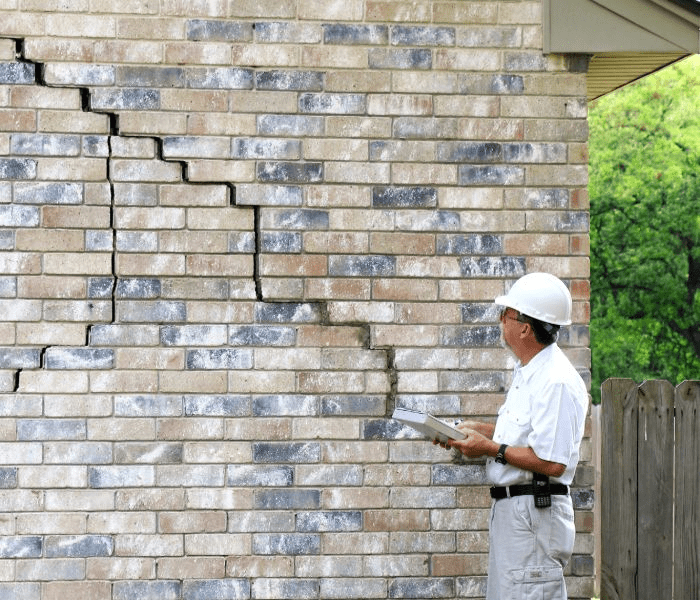Have you been putting off home foundation repair? If so, it’s time to call a foundation repair contractor! The longer you ignore cracks, leaks, chips, and other damage, the more extensive they become. In turn, you’ll end up paying thousands of dollars more for repairs and might even see property values plummet.
To avoid these risks, you might note signs that it’s time for residential foundation fixes. You can then discuss issues around your property with a foundation repair contractor as needed. With this in mind, note some common indicators of needed home foundation repair in the Woodlands.
Interior indicators of needed home foundation repair in the Woodlands
To note if you need to schedule house foundation repair in The Woodlands, start with some common indicators you might find inside your home. While many of these can have various causes, don’t rule out foundation damage as well!
Drywall damage
As a foundation weakens, it pulls on drywall panels. In turn, it’s not unusual to notice wall and ceiling cracks in a home with foundation damage. Additionally, pulling on drywall can result in popped nails or panels separating from one another. You might then notice gaps in room corners.
Doors and windows
A shifting, sinking foundation also pulls door and window frames out of a level position. You might then notice windows sticking and becoming difficult to operate. Also, doors might stick or hang open on their own. It can also become difficult to close deadbolts and locking mechanisms properly!
Flooring damage
Uneven floors also might indicate foundation damage. If you notice a child’s toy car or ball rolling on its own, this usually means the floors are sinking and it’s time for foundation repair! Hardwood floor planks might also pop out of position. Planks and floor tiles can also come loose from the adhesion under them.
Also, note that a sinking foundation often results in cracked subflooring. In turn, you might notice creaking, squeaking, and groaning when you walk across those floors. Floorboards might also feel soft or spongy under your feet.
Dampness and mold
Foundation cracks and leaks let moisture into your home. Consequently, you might notice mold growth behind walls or mildew under carpeting. Also, your home’s basement or utility rooms might feel damp and musty.
Exterior indicators that it’s time for home foundation repair
While a homeowner should never rely on their own inspections to determine if their home needs foundation repair, it is helpful to check exposed concrete or piers and beams regularly. Look for cracks and spalling along concrete surfaces. Also, note if piers seem cracked or if they appear to be leaning.
A property owner might also check a crawlspace for excessive moisture and mold or wood rot along a structure’s underside. If your home has a basement, never overlook bowing or sagging walls! Additionally, consider if basement windows suddenly stick or if gaps form around them.
Lastly, consider if your home’s foundation has been exposed to excessive moisture over the years. Improper soil grading and clogged gutters can allow moisture to sit against the foundation. Consequently, it’s likely to crack and chip in areas not visible with a quick inspection. In those cases, call a repair contractor for a professional inspection.
Are foundation repairs common in Texas?
Unfortunately for area homeowners, foundation repairs are common in Texas, perhaps more so than in any other state in the union! Expanding clay soil, so common in this area, is one reason for persistent foundation issues.
As the soil expands, it puts pressure on foundation concrete, risking cracks and other damage. Also, clay soil shrinks as it dries out. As it does, it fails to offer a foundation needed support. In turn, that foundation settles and shifts, also risking cracks and leaks.
The state’s unpredictable weather patterns also put pressure on a home’s foundation. Texas weather is often hot and dry but it can also suffer frost and even snowfall. This weather changes also cause soil to expand and shrink or might risk moisture collecting around foundation concrete. In turn, foundation repairs are somewhat common in Texas.
Lastly, note that many homeowners in Texas might avoid needed fixes and maintenance, simply because they don’t realize the dangers! Some homeowners might assume that snowy or damp weather poses the biggest risks for foundations. While moisture risks foundation cracks, so do the state’s unpredictable and ever-changing weather cycles.
How can foundation problems be avoided?
As with homes in any other state, you can avoid foundation problems with a few simple steps. These will ensure that the foundation stays strong and stable over the years.
- First, have a foundation inspected by a professional regularly. Don’t rely on your own visual inspection when it comes to spotting signs of damage. A professional will check in hidden areas and for signs of a weak foundation all along your property as well as along a foundation surface.
- Next, invest in regular waterproofing services. A waterproof coating keeps damaging moisture away from foundation concrete, reducing the risk of damage.
- Also, ask a foundation repair contractor about needed sump pump or French drain installation, or better soil grading. These steps help direct moisture in the soil away from your home, protecting the foundation from damage.
- For pier and beam foundations, consider full-scale crawlspace encapsulation or a vapor barrier. These also help to repel moisture, keeping it from piers and beams and your home’s underside.
- You might not associate your home’s gutters with its foundation but the entire purpose of gutters is to direct water away from the structure and to nearby downspouts. Those downspouts then push water in the opposite direction of your home, preventing it from collecting around the foundation. In turn, you should ensure your home’s gutters are always clean and clog-free.
Note, too, that you should schedule needed house foundation repair in The Woodlands as soon as it’s necessary. Ignoring cracks and chips only lets them get worse, as said. Timely repairs then keep your cost low and also help prevent costly secondary damage such as wall cracks and mold growth!




